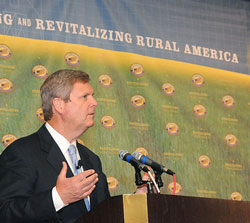 The only Indy race to still run on homegrown corn ethanol is just around the corner. The 2010 Iowa Corn Indy 250, presented by Pioneer, will once again showcase 100% race powered corn-ethanol during the 4th annual race in Newton, Iowa on June 20.
The only Indy race to still run on homegrown corn ethanol is just around the corner. The 2010 Iowa Corn Indy 250, presented by Pioneer, will once again showcase 100% race powered corn-ethanol during the 4th annual race in Newton, Iowa on June 20.
2010 Indy 500 winner Dario Franchitti won the very first Iowa Corn Indy in 2007, when the series first started using 100 percent ethanol. He says Indy’s transition to ethanol was a winner. “It was a big deal for us when we first switched over to ethanol,” he said during an Indy racing press conference Monday. “We’ve had tremendous success as a series with ethanol and had a really seamless transition. It’s just been a real win-win situation for the IndyCar Series.”
The Iowa Corn Indy 250 has been a win-win for Franchitti, who won it again in 2009. He hopes to be able to take home a third fuel-pump designed trophy this year.
The Iowa Corn Indy 250 is presented by Pioneer, with support from the Iowa Corn Promotion Board and the Iowa Corn Grower’s Association. It is the only Indy race this year to run on corn ethanol, since Brazil’s ethanol industry has taken over sponsorship of the series and provides fuel for the rest of the races.
Listen to or download Franchitti’s comments about ethanol in the player below:


 U.S. Secretary of Agriculture Tom Vilsack believes that the Environmental Protection agency will increase the amount of ethanol allowed in regular gasoline above the current ten percent.
U.S. Secretary of Agriculture Tom Vilsack believes that the Environmental Protection agency will increase the amount of ethanol allowed in regular gasoline above the current ten percent. The
The  The Brazilian Innovation Agency, FINEP (Research and Projects Financing), and Brazil’s National Development Bank have entered into a new partnership to promote bioethanol development, providing up to $540 million in financing to the country’s biofuels sector to promote innovation in the field of bioethanol.
The Brazilian Innovation Agency, FINEP (Research and Projects Financing), and Brazil’s National Development Bank have entered into a new partnership to promote bioethanol development, providing up to $540 million in financing to the country’s biofuels sector to promote innovation in the field of bioethanol. Biomass refinery developer
Biomass refinery developer 

 The expansion of biofuels will play a significant role in the revitalization of rural America, according to U.S. Secretary of Agriculture Tom Vilsack.
The expansion of biofuels will play a significant role in the revitalization of rural America, according to U.S. Secretary of Agriculture Tom Vilsack.

 “If we refuse to take into account the full costs of our fossil fuel addiction — if we don’t factor in the environmental costs and the national security costs and the true economic costs — we will have missed our best chance to seize a clean energy future.”
“If we refuse to take into account the full costs of our fossil fuel addiction — if we don’t factor in the environmental costs and the national security costs and the true economic costs — we will have missed our best chance to seize a clean energy future.” However, the
However, the